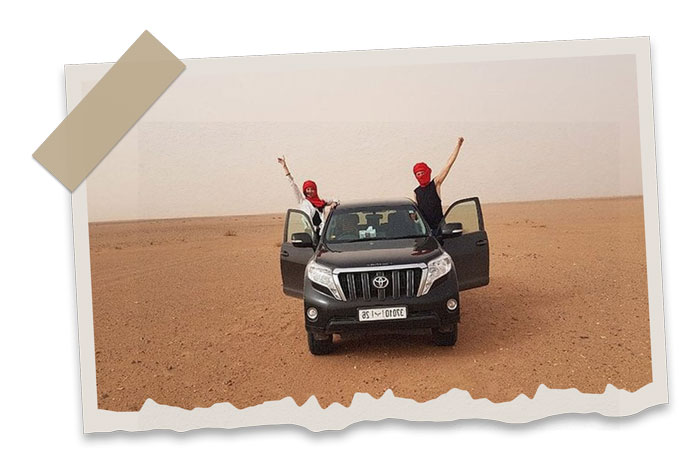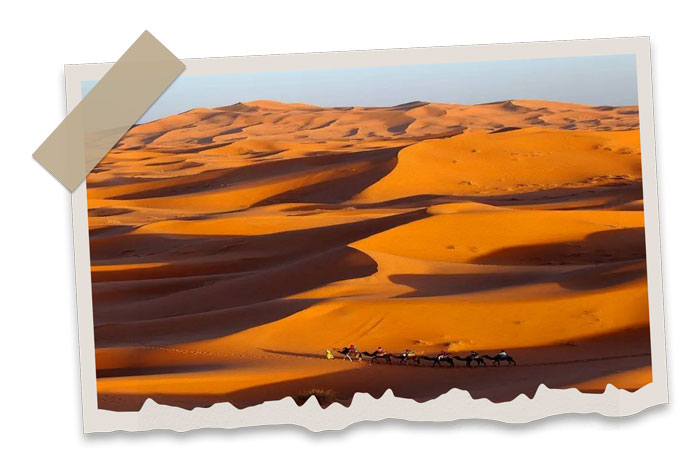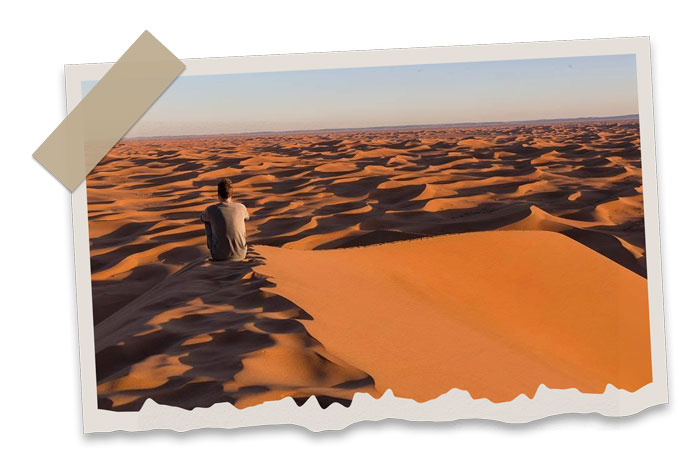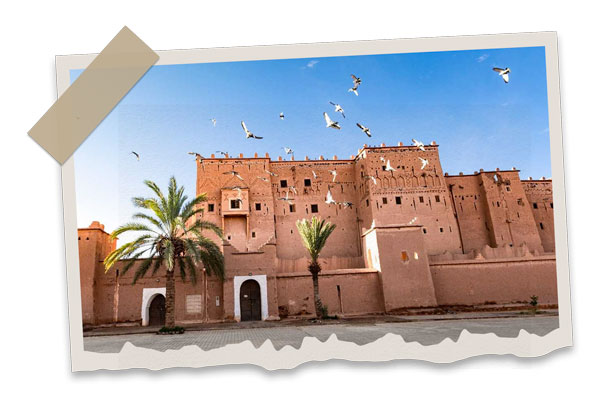Visit the Moroccan Sahara Desert – What to Bring With You?
Are you planning a magical journey to the Morocco Sahara Desert? Picture this: golden dunes rolling to the horizon, dramatic sunsets, and star-filled skies that look like a painting. But before you can ride camels or sleep under Berber tents, you’ll need to pack wisely. The Sahara isn’t just sand—it’s extremes of hot days, cold nights, and unpredictable elements.
This Sahara Desert travel packing guide will help you prepare for the adventure of a lifetime. Whether you’re going on a short desert tour or a multi-day trek, here’s what to bring to the Sahara Desert in Morocco.
Why Packing Smart for the Sahara Desert Matters
Traveling to the Sahara Desert in Morocco isn’t like packing for Marrakech or Chefchaouen. Temperatures can soar above 40°C (104°F) during the day and drop to near freezing at night. You’ll be miles from shops or modern facilities, so what you pack matters. The right gear will keep you comfortable, safe, and prepared for the wild beauty of the desert.
Essential Clothing for the Morocco Sahara Desert
When thinking about what to wear in the Sahara Desert, layering is key. Here’s your go-to clothing list:
Daytime Essentials:
-
Lightweight, breathable clothing – long sleeves and pants to protect from sun and sand
-
Loose cotton or linen shirts
-
Harem pants or light hiking trousers
-
Wide-brimmed hat or desert scarf (cheche) for sun protection
-
Sunglasses with UV protection
-
Comfortable walking sandals or lightweight hiking shoes
Nighttime Warmth:
-
Fleece or insulated jacket (yes, it gets cold!)
-
Thermal base layer for chilly evenings
-
Wool socks and a beanie or warm hat
Optional:
-
Swimsuit (some luxury camps or riads have pools)
-
Undergarments and sleepwear suitable for varying temperatures
Travel Gear and Accessories for Desert Tours
Your desert tour might include camel rides, 4×4 drives, or hiking dunes. Here’s what to bring to the Morocco Sahara Desert beyond just clothes:
Travel Essentials:
-
Small backpack or daypack for day trips
-
Duffel bag or soft-sided suitcase for easier transport on camels or jeeps
-
Reusable water bottle (1L or more) – hydration is critical
-
Headlamp or flashlight for nighttime in camp
-
Power bank – camps may have limited electricity
-
Camera or smartphone with good battery life for stunning desert photography
Ready to Plan Your Sahara Adventure?
Join our Morocco Sahara Desert tour and experience the magic of the desert! From camel trekking through the golden dunes to an overnight stay under the stars in a desert camp, every moment is filled with wonder. Plus, you’ll have the chance to visit the vibrant Rissani Big Souk, where you can explore traditional markets, local handicrafts, and the authentic atmosphere of Morocco’s ancient trading hub. Book your tour today and discover the beauty of the Sahara like never before!
Toiletries and Personal Care
You won’t find convenience stores in the desert, so pack these Sahara essentials:
-
Sunscreen SPF 30+
-
Lip balm with SPF
-
Wet wipes or biodegradable cleansing wipes
-
Toilet paper and hand sanitizer
-
Moisturizer (dry desert air = dry skin!)
-
Basic first-aid kit: plasters, antiseptic cream, pain relievers, motion sickness tablets
-
Any personal medication (enough for your entire trip)
Extra Comfort and Travel Hacks
These items aren’t “must-haves” but they’ll upgrade your Sahara experience:
-
Travel pillow or neck pillow for long drives
-
Sleep sheet or travel liner for extra hygiene
-
Earplugs (for windy nights or snoring travelers)
-
Snacks – energy bars, dried fruit, nuts
-
Notebook or travel journal to capture your reflections under the stars
What NOT to Bring to the Sahara Desert
-
Heavy suitcases (difficult to carry in sand)
-
High heels or dress shoes
-
Overpacking clothes (stick to light, versatile items)
-
Perfume or scented products (they attract insects)
Is the Moroccan Sahara Desert Barren?
Many first-time travelers picture the Moroccan Sahara Desert as a vast, empty wilderness, but that’s only part of the story. While the Sahara is known for its dramatic sand dunes and remote beauty, it’s far from barren when it comes to visitor comfort and essential resources.
In fact, the Moroccan Sahara offers everything you need for a memorable and comfortable experience, even if you choose to travel light. From local markets in towns like Merzouga and Zagora to the luxury desert camps scattered across Erg Chebbi and Erg Chigaga, you’ll find plenty of options to get what you need without overpacking.
What You Can Expect in the Sahara:
-
Luxury accommodations with private bathrooms, electricity, and heating
-
Desert camps that provide warm blankets, comfortable bedding, and meals
-
Shops offering essentials like scarves, sun hats, bottled water, and basic toiletries
-
Friendly Berber hosts who are ready to assist with anything you might need
So, if you’re wondering whether you need to carry a heavy suitcase into the dunes, you don’t. The Moroccan Sahara is not only breathtaking, it’s also surprisingly well-prepared for travelers.
Visit the Moroccan Sahara Desert: What to see and where to stop?
Merzouga and the Erg Chebbi Dunes
Merzouga is one of the most iconic destinations in the Moroccan Sahara, located near the Algerian border in southeastern Morocco. This small desert town is renowned for its proximity to the Erg Chebbi dunes, a spectacular stretch of golden sand hills that can reach heights of up to 150 meters. These dunes offer the quintessential Sahara experience. Visitors often arrive to enjoy camel trekking across the vast sea of sand, especially during sunrise or sunset when the colors shift dramatically across the landscape. Spending a night in a traditional Berber tent or a luxury desert camp under the stars is a highlight for many travelers. Nearby, the village of Khamlia is known for its Gnawa music, performed by descendants of former Sub-Saharan slaves. The rhythms, hospitality, and culture here give insight into the soulful traditions of southern Morocco.

Zagora and the Draa Valley
Zagora lies in the Draa Valley, an arid yet stunning area framed by palm groves, oases, and historic kasbahs. Though it doesn’t have the towering dunes of Merzouga, Zagora is considered the “gateway to the real Sahara” and serves as a starting point for desert tours heading deeper into the wilderness. Historically, this region was part of the ancient caravan route to Timbuktu, a fact still remembered by a famous sign that reads “Timbuktu 52 days.” The surrounding Draa Valley is lined with mudbrick villages and lush oases, making it ideal for cultural exploration and photography. From Zagora, many visitors continue south toward M’Hamid and Erg Chigaga for a deeper desert adventure.

M’Hamid El Ghizlane and Erg Chigaga
M’Hamid El Ghizlane is the last settlement before the road gives way to open desert. It is here where the paved roads end and the raw, untouched Sahara begins. This small, windswept village is the launch point for expeditions into the remote Erg Chigaga dunes, located about 60 kilometers to the west. Unlike Erg Chebbi, Erg Chigaga is only accessible by off-road vehicles or camels, which means fewer tourists and a more wild, authentic desert experience. The dunes themselves are vast and stunning, with fewer camps and less light pollution, making stargazing here truly unforgettable. Tours from M’Hamid often include overnight stays in nomadic-style tents, campfire dinners, and complete immersion in the natural silence of the desert.

Ouarzazate and Ait Ben Haddou
While not deep in the desert, Ouarzazate is often considered the doorway to the Sahara and is a common starting point for many desert tours. The city is home to the famous Atlas Studios, where Hollywood films like Gladiator, Lawrence of Arabia, and Game of Thrones were shot. Just 30 kilometers away lies Ait Ben Haddou, a UNESCO World Heritage site and ancient ksar (fortified village) made of earthen clay. Its dramatic setting and architectural beauty make it a perfect stop on the way to the Sahara. From Ouarzazate, travelers usually continue southeast toward the Dades and Todra Gorges before reaching the dunes of Merzouga or Zagora.

Todra and Dades Gorges
Though not part of the Sahara proper, the Todra and Dades Gorges are often included in desert tours and serve as scenic and adventurous stops on the way to Merzouga. The Todra Gorge, near Tinghir, is a dramatic canyon with sheer limestone walls rising up to 300 meters, perfect for hiking and rock climbing. The Dades Valley, with its winding road known as the “road of a thousand kasbahs,” showcases striking red rock formations and traditional Berber villages perched along the cliffs. These gorges provide a striking contrast to the flat desert and serve as a refreshing, photogenic detour before reaching the Sahara dunes.

Rissani
Located just an hour from Merzouga, Rissani is a historic trading town that once served as a major stop for trans-Saharan caravans. Today, it offers travelers a chance to experience an authentic Moroccan market (souk) with fewer tourists. The town is known for its traditional architecture, donkey parking lot, and local delicacies such as Medfouna, often called “Berber pizza.” Rissani also holds religious significance, as it is the birthplace of the Alaouite dynasty, Morocco’s ruling royal family. A short visit here adds cultural depth to any Sahara itinerary.

